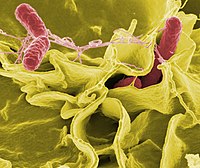
Cholera Toxin Subunit B Enabled Multifunctional Glioma‐Targeted Drug Delivery
Sign Up to like & getrecommendations! Published in 2017 at "Advanced Healthcare Materials"
DOI: 10.1002/adhm.201700709
Abstract: Glioma is among the most formidable brain cancers due to location in the brain. Cholera toxin subunit B (CTB) is investigated to facilitate multifunctional glioma-targeted drug delivery by targeting the glycosphingolipid GM1 expressed in the… read more here.
Keywords: ctb; glioma; multifunctional glioma; toxin subunit ... See more keywords

Detection of Cholera Toxin by an Immunochromatographic Test Strip.
Sign Up to like & getrecommendations! Published in 2017 at "Methods in molecular biology"
DOI: 10.1007/978-1-4939-6958-6_1
Abstract: As cholera toxin (CT) is responsible for most of the symptoms induced by Vibrio cholerae O1 or O139 infection, detection of CT is an important biomarker for diagnosis of the disease. The procedure for pathogenicity… read more here.
Keywords: cholerae; cholera toxin; test strip; immunochromatographic test ... See more keywords

Red fluorescent AuNDs with conjugation of cholera toxin subunit B (CTB) for extended-distance retro-nerve transporting and long-time neural tracing.
Sign Up to like & getrecommendations! Published in 2019 at "Acta biomaterialia"
DOI: 10.1016/j.actbio.2019.11.045
Abstract: A retrograde transportation nerve probe, Au nanodots-cholera toxin B subunit (AuNDs-CTB), are prepared and fully characterized, which emit bright red fluorescence and show high quantum yield (7.2%) and good stability. The fluorescence emitted by the… read more here.
Keywords: fluorescence; toxin subunit; long time; nerve ... See more keywords

Highly affine and selective aptamers against cholera toxin as capture elements in magnetic bead-based sandwich ELAA.
Sign Up to like & getrecommendations! Published in 2018 at "Journal of biotechnology"
DOI: 10.1016/j.jbiotec.2018.01.012
Abstract: Aptamers are single-stranded DNA or RNA oligonucleotides, which have been emerging as recognition elements in disease diagnostics and food control, including the detection of bacterial toxins. In this study, we employed the semi-automated just in… read more here.
Keywords: elaa; toxin; sandwich elaa; capture ... See more keywords

Nedd4-2-dependent ubiquitination potentiates the inhibition of human NHE3 by Cholera toxin and enteropathogenic E. coli.
Sign Up to like & getrecommendations! Published in 2021 at "Cellular and molecular gastroenterology and hepatology"
DOI: 10.1016/j.jcmgh.2021.11.006
Abstract: BACKGROUND & Aims Diarrhea is one the most common illnesses and is often caused by bacterial infection. Recently, we have shown that human Na+/H+ exchanger NHE3 (hNHE3), but not non-human NHE3s, interacts with the E3… read more here.
Keywords: enteropathogenic coli; nhe3; nedd4 hnhe3; hnhe3 ... See more keywords

Cholera toxin induces food allergy through Th2 cell differentiation which is unaffected by Jagged2.
Sign Up to like & getrecommendations! Published in 2020 at "Life sciences"
DOI: 10.1016/j.lfs.2020.118514
Abstract: AIMS Cholera toxin is often used to induce food allergies. However, its exact mode of action and effect remain ambiguous. In this study, we established a BALB/c mouse cholera toxin/ovalbumin-induced food allergy model to determine… read more here.
Keywords: allergy; toxin; differentiation; food ... See more keywords

The role of CTX and RS1 satellite phages genomic arrangement in Vibrio cholera toxin production in two recent cholera outbreaks (2012 and 2013) in IR Iran.
Sign Up to like & getrecommendations! Published in 2017 at "Microbial pathogenesis"
DOI: 10.1016/j.micpath.2017.09.032
Abstract: The objective of the present study was to investigate the genomic arrangement of CTX/RS1 prophages in 30 Vibrio cholerae strains obtained from 2 consecutive years of cholera outbreak and to compare the role of different… read more here.
Keywords: ctx; ctx rs1; arrangement; cholera ... See more keywords

Modifications of cholera toxin subunit B binding to human large intestinal epithelium. An immunohistochemical study.
Sign Up to like & getrecommendations! Published in 2018 at "Microbial pathogenesis"
DOI: 10.1016/j.micpath.2018.08.047
Abstract: Binding of cholera toxin subunit B (CTB) to its receptor and toxin transport into the intestinal epithelial cells are the causative events for the potentially lethal disease cholera. The five sugar mono-sialo ganglioside GM1 is… read more here.
Keywords: ctb; toxin subunit; toxin; goblet cells ... See more keywords

Purification and characterization of a novel cell-penetrating carrier similar to cholera toxin chimeric protein.
Sign Up to like & getrecommendations! Published in 2017 at "Protein expression and purification"
DOI: 10.1016/j.pep.2016.03.007
Abstract: Developing a recombinant vector for noninvasively delivering biological macromolecules into the brain is important. This study constructed and purified a protein complex based on the cholera toxin (CT) molecular structure. Enhanced green fluorescent protein (EGFP)-modified… read more here.
Keywords: protein; cell; carrier; cholera toxin ... See more keywords

Targeting Multiple Binding Sites on Cholera Toxin B with Glycomimetic Polymers Promotes Formation of Protein-Polymer Aggregates.
Sign Up to like & getrecommendations! Published in 2020 at "Biomacromolecules"
DOI: 10.1021/acs.biomac.0c01122
Abstract: The canonical binding site on the B subunit of cholera toxin (CTB) binds to GM1 gangliosides on host cells. However, the recently dis-covered noncanonical binding site on CTB with affinity for fucosylated molecules has raised… read more here.
Keywords: cholera toxin; protein polymer; binding; binding sites ... See more keywords

Microgels Sopping Up Toxins-GM1a-Functionalized Microgels as Scavengers for Cholera Toxin.
Sign Up to like & getrecommendations! Published in 2019 at "ACS applied materials & interfaces"
DOI: 10.1021/acsami.9b06413
Abstract: Vibrio cholerae is a Gram-negative bacterium that causes secretory diarrhea and constitutes a major health threat in the industrialized world and even more in developing countries. Its main virulence factor is the cholera toxin, which… read more here.
Keywords: microgels sopping; functionalized microgels; gm1a functionalized; toxin ... See more keywords